Sergey Eylanbekov – “SYMBOLIST SPORTS SCULPTOR” – 2004 SPORT ARTIST OF THE YEAR
Artist Biography | Style & Inspiration | Key Sport Works & World Influence
“Every good sculpture should possess some concealed energy within, the kind of energy that is felt beyond the physical limits of the work.” ~ Sergey Eylanbekov
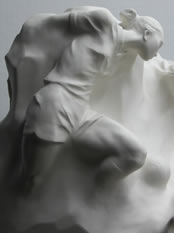
FIFA Women’s World Cup 2008
Eylanbekov’s statement that good sculpture should radiate energy is similar to Abstract Expressionist painter, Mina Papatheodorou-Valyraki’s statement that she aims to extend her works’ sensations beyond the canvas: “I don’t have restricted boundaries. I always want to go outside the frame anyway. Almost all my works are cut off. The remainder of their ‘being,’ the imaginary, exists outside the frame”(Dialogue about Art, Livani Publishing, p. 31). Valyraki acknowledges the work of Russian artist, Wassily Kandinsky as one of her key influences. In 1908, he was one of the first artists to elevate Expressionism beyond personal emotions into a larger spiritual realm when he fused it with Russian Byzantinism’s abstract symbolism. Kandinsky was a master of the Gestural Avant Garde style in which the gesture of the artist held prime value either in its record in a painter’s brushstroke or a sculptor’s chisel scraping. Tool marks were intentionally left unsmoothed to convey the personal touch and energetic intent of the artist more directly.
“Art is interested in life at the moment when the ray of power is passing through it.” ~ Boris Pasternak, author; www.people.ubr.com
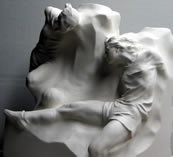
FIFA Women’s World Cup 2008
Eylanbekov’s style of sculpting includes many works in which he uses this Contemporary Expressionist approach with strong Symbolist influences. Rigorously trained in drawing and sculpting the human body with anatomical precision, Eylanbekov often alters his figures slightly to communicate something about the subject’s emotions or energy rhythms. His bronze sculptures are recognizable representations of their subjects’ faces with subtle added strokes and distortions that heighten the portraits of their characters and moods. These techniques indicate strong influence by art from the Abstract Expressionist as well as Gestural movements. They give his human figures intense vitality along with a dose of mystery from the implicit energy.
“Overall, my style probably could be described as Contemporary Expressionism with a large dose of Symbolism.” ~ Sergey Eylanbekov
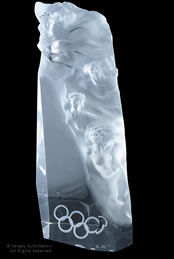
5 Continents Fragment
The masterful works of American artist, Leonard Baskin, are important influences on Eylanbekov’s art. Baskin rejected the confines of media specialization and the devaluation of figural humanism embraced by many of his contemporaries. Eylanbekov clearly shares Baskin’s interest in figural sculpture and drawing as well as an affinity for archetypal, sometimes unsettling themes. Baskin’s symbolic portraits in ink and bronze stand as some of the finest, most original artworks of the 20th century.
“Sculpture at its greatest and most monumental is about simple, abstract, emotional states, like fear, pride, love, envy.” ~ Leonard Baskin
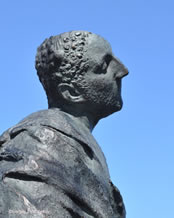
Henrik Ibsen
Along with Auguste Rodin and Alberto Giacometti, Eylanbekov cites the styles of two Italian 20th century sculptors as major influences on his work. Giacomo Manzu produced somber religious sculptures of elongated human figures much influenced by the figures in Romanesque cathedrals. He was also influenced by ancient Etruscan art and its tall, stately, stylized portraits. Manzu was devoted to using the human figure to convey universal symbolic themes. His contemporary, Marino Marini also sculpted elongated figures but he imbued them with his signature qualities of lightness, humor, and personal mythology. Marini was greatly influenced by his colleague, Henry Moore whose streamlined sculptural forms had a significant impact on the styles of many contemporary artists.
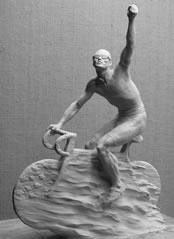
Lance Armstrong
After the 1980s, Pluralism, or the freedom to use any styles in any combinations became the approach of most artists. Eylanbekov combines the rebellious mood-enhancing techniques of the Expressionists with the precise artistic skills of traditional approaches into his unique, powerful style.
Eylanbekov’s art career has been raised to a new level of excellence by his mastery of a contemporary technique employing sculpture-grade acrylics. First used for fine artworks by 20th century American master sculptor, Frederick Hart, the use of acrylic material to create multi-layered carvings is a technique that Eylanbekov has modified and made his own. Some of his finest sports sculptures are created in this medium. The images take on the appearance of moving through the atmosphere as the opaque blocks of acrylic are rotated, and the figures emerge from different angles. Even more than on bronze sculptures, light and shadow take major roles as they filter through an acrylic realm modifying the form and mood of the piece in various positions.
“Sculpting with acrylics is sculpting with light.” ~ Frederick Hart; www.angelakinggallery.com
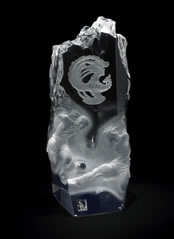
Fenghuang
The Russian composer, Sergei Rachmaninov said of his creative pursuits, “Music is enough for a lifetime, but a lifetime is not enough for music.” In light of the enthusiastic public response to Eylanbekov’s impressive sculptures, it is clear that Eylanbekov’s works will continue to enlighten and delight viewers for many lifetimes to come.
image sources
- Sergey-features: Sergey Eylanbekov

